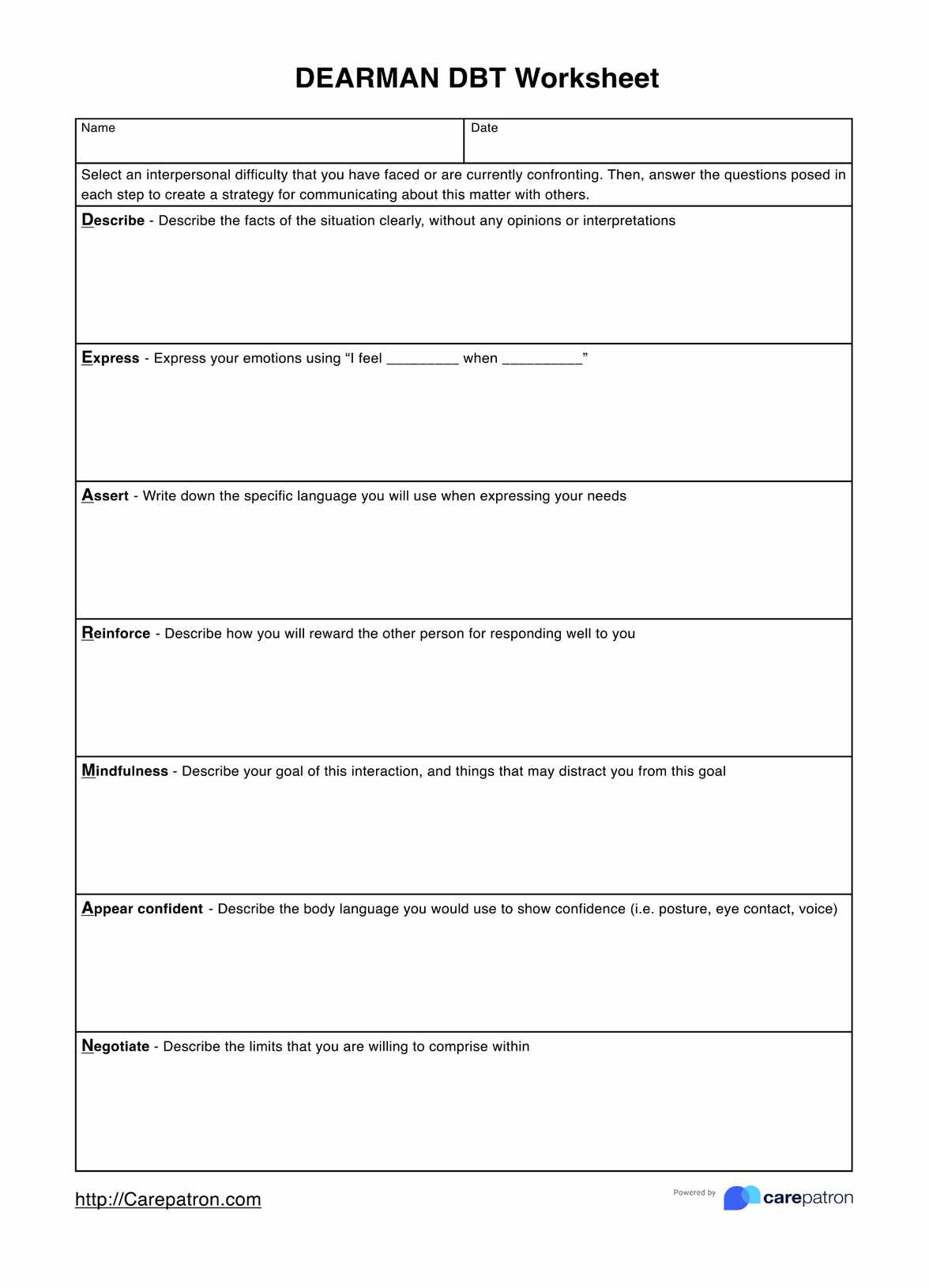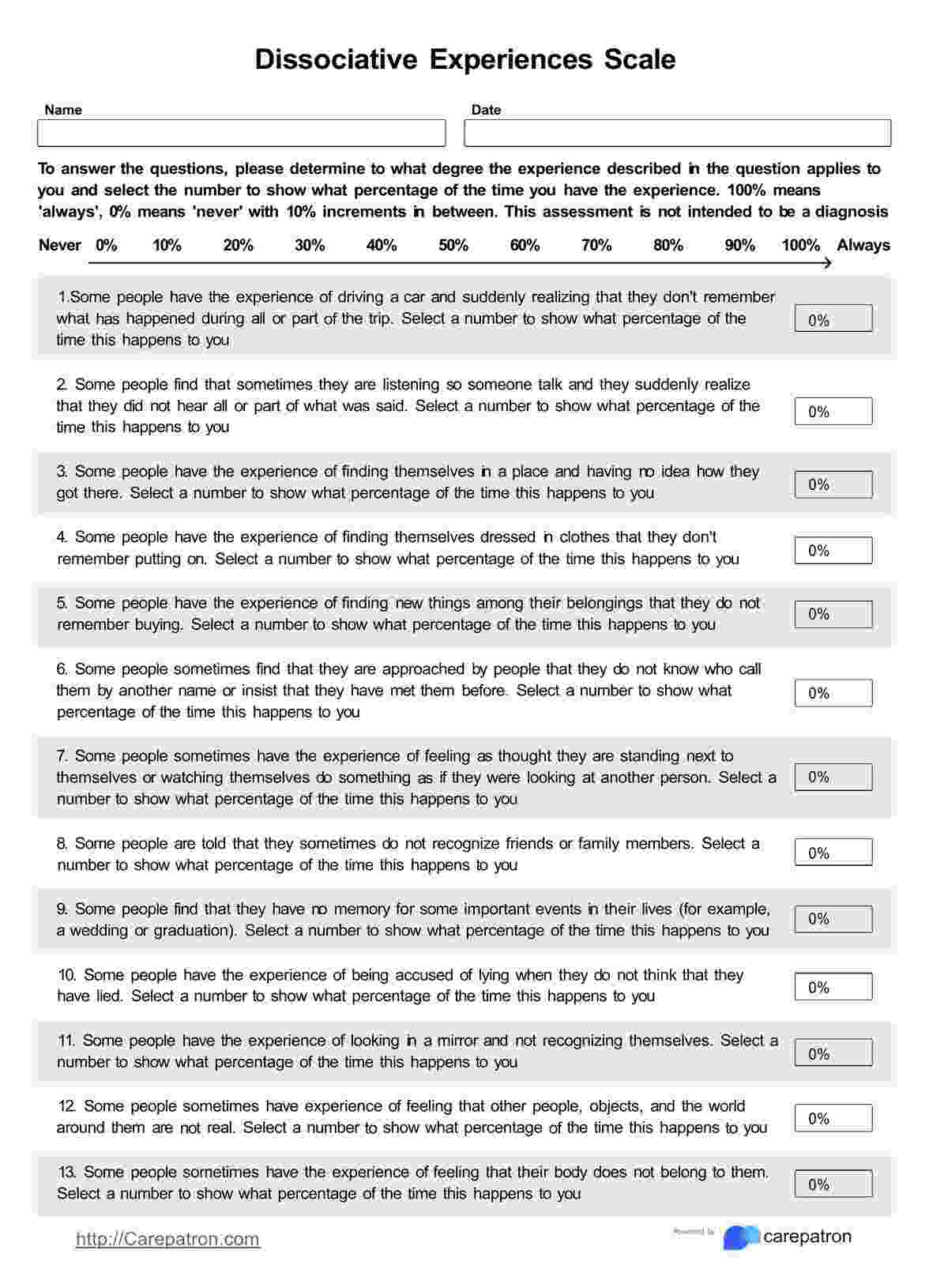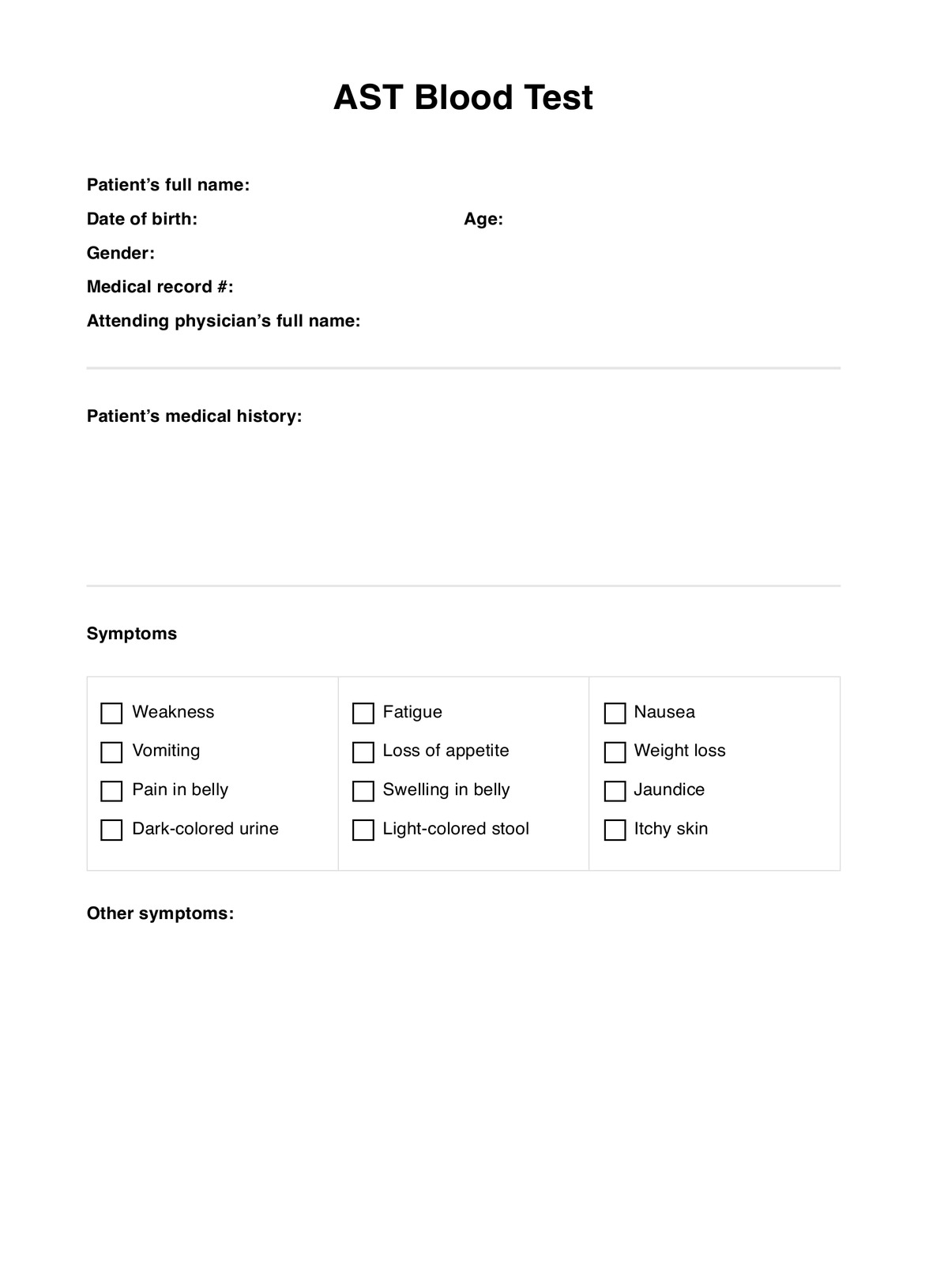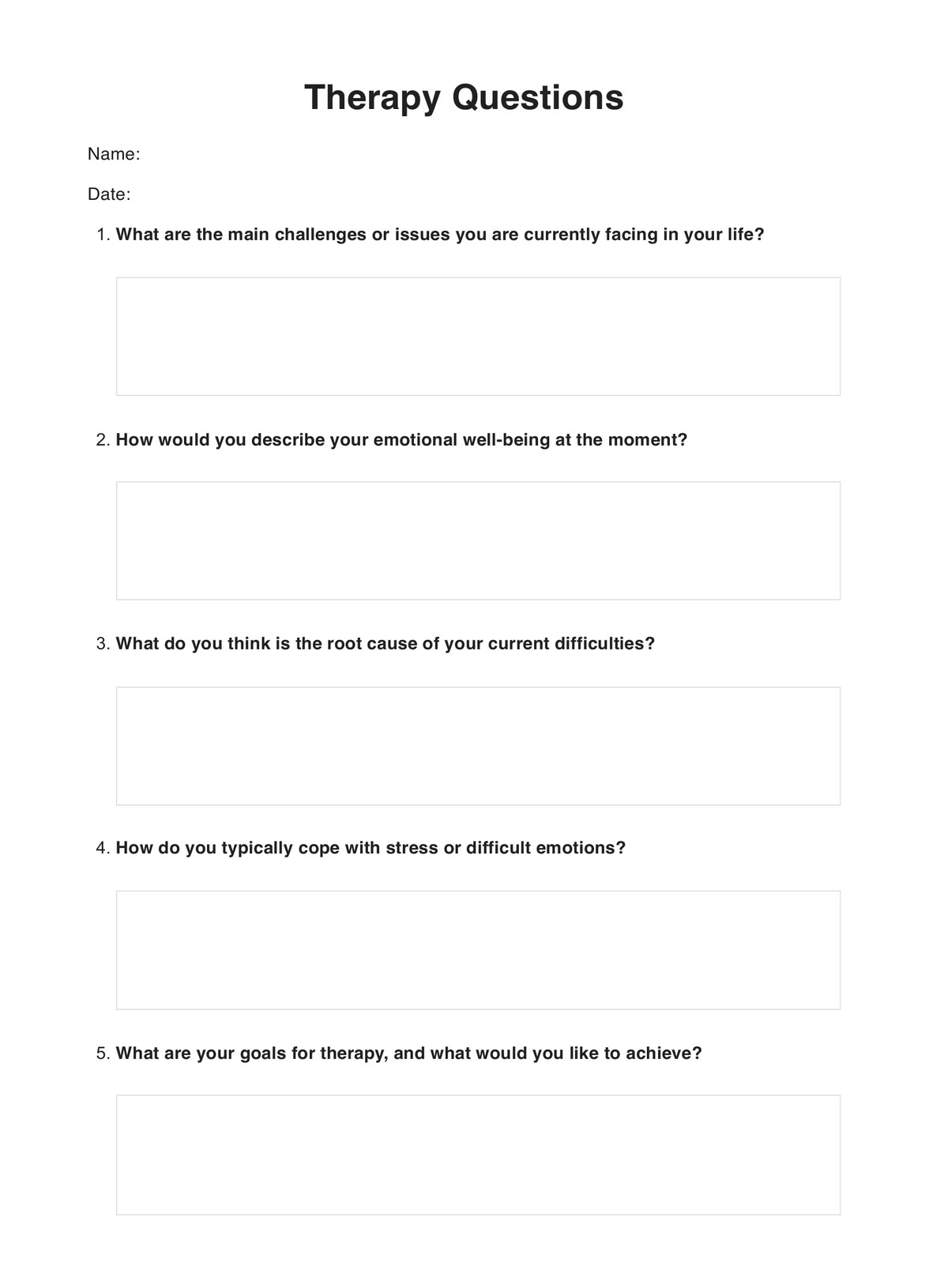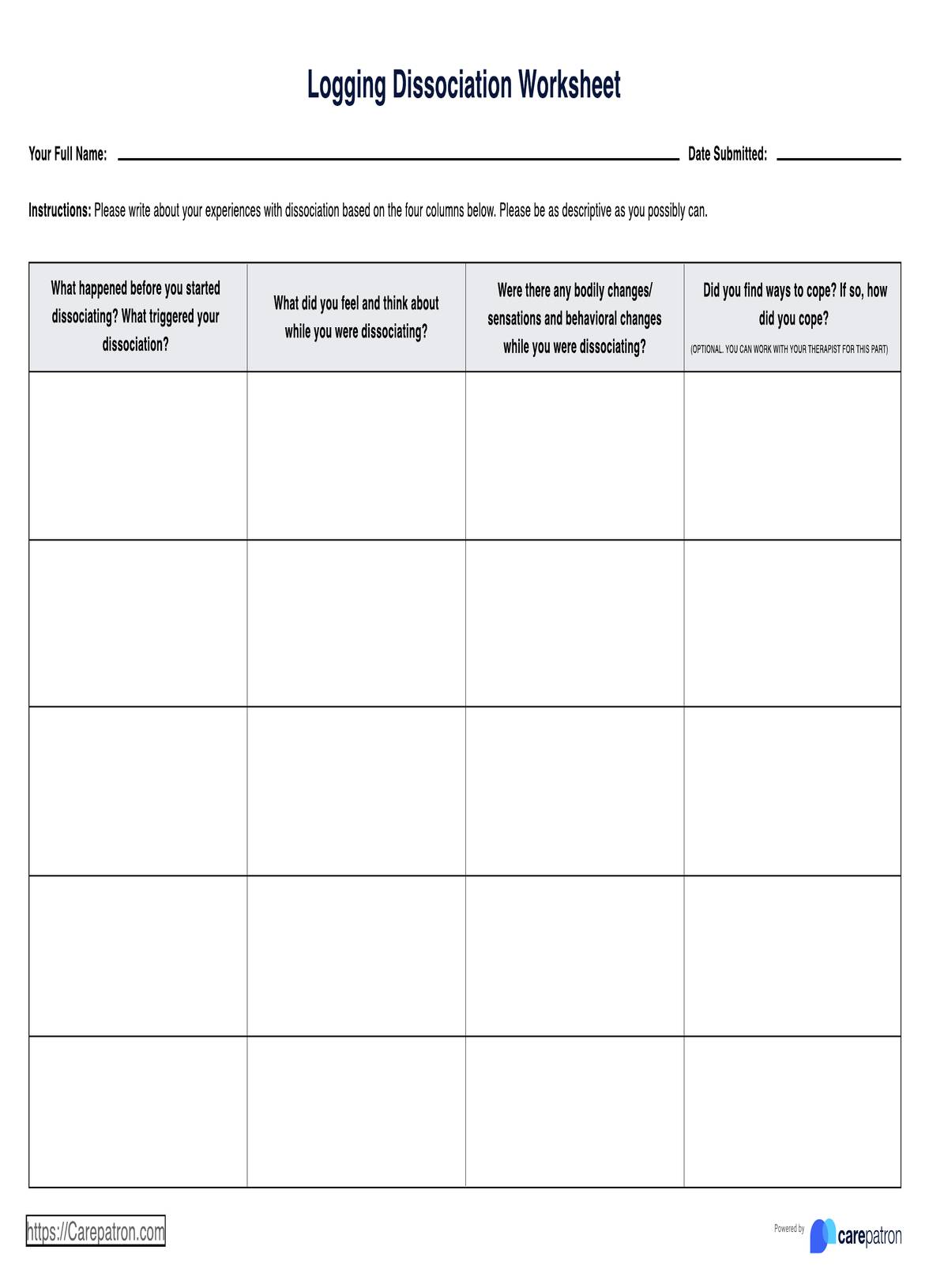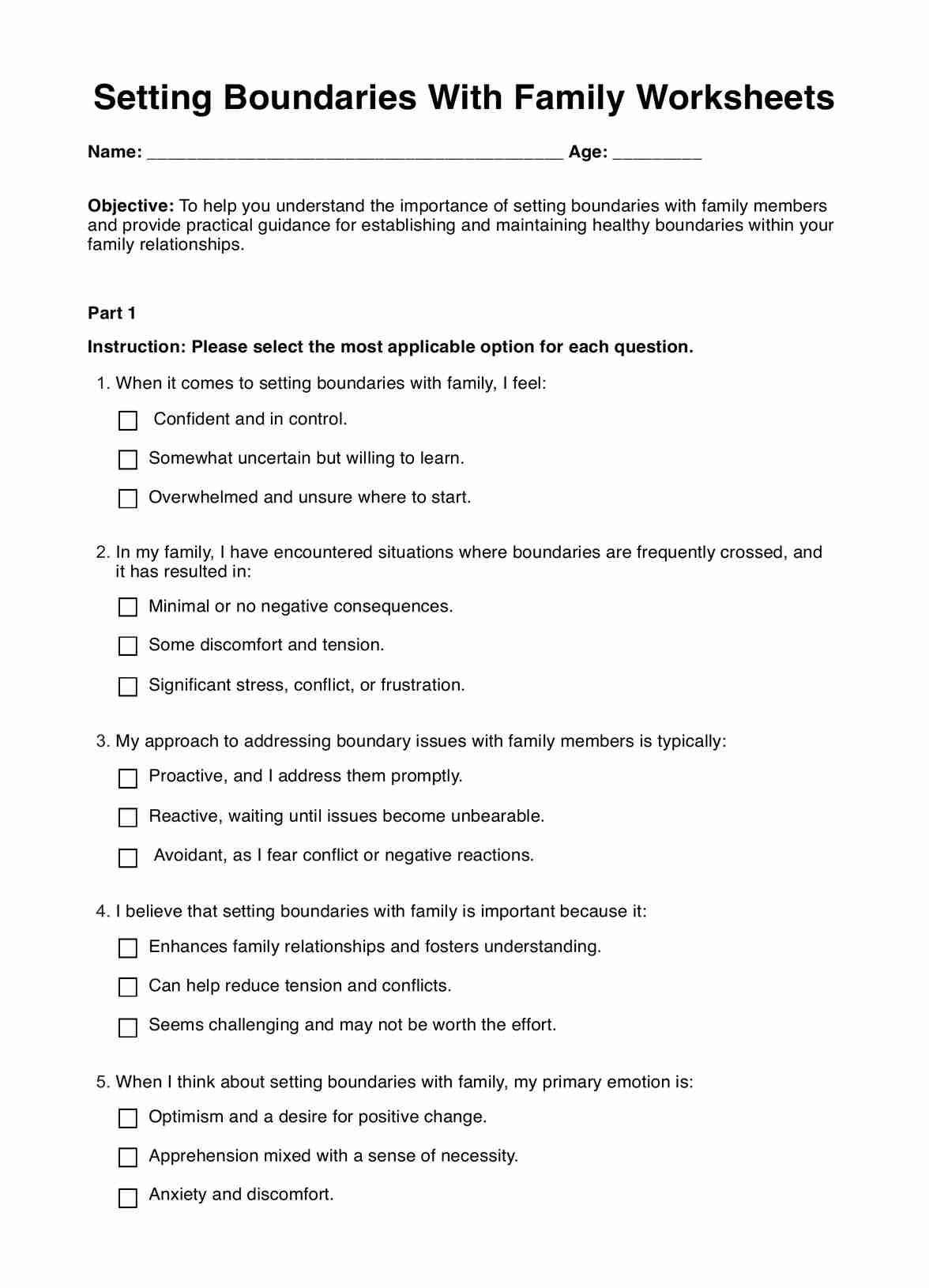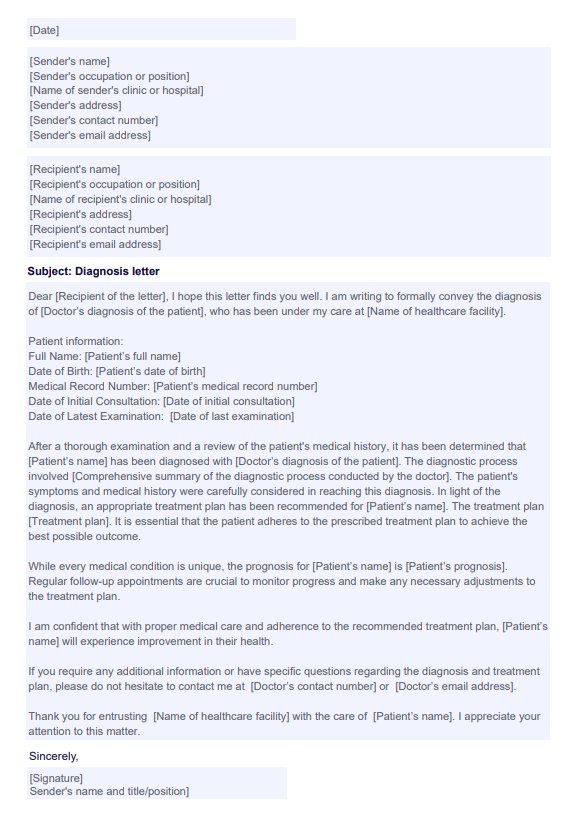Picky Eater Test
Discover our comprehensive Picky Eater Test and learn how to identify picky eating habits. Download our free PDF and assess your food preferences today!


What is a Picky Eater Test?
A Picky Eater Test is a valuable tool designed to assess an individual's eating habits and level of pickiness regarding food choices. The test consists of questions or statements that delve into one's eating preferences, habits, and aversions. By analyzing the responses, the test can offer insights into how selective or open someone is when trying new foods or eating various meals.
This test is handy for parents, educators, and healthcare professionals who want to understand a child's eating behavior better, identify potential issues, and develop strategies to address concerns.
Picky eating can sometimes be a temporary phase, especially in children, but it can also persist into adulthood, leading to limited diets that lack essential nutrients. Early identification of picky eating habits can help support healthy eating and prevent nutritional deficiencies.
Our templates provide a comprehensive and easy-to-use assessment that anyone can use to evaluate their eating habits or those of others. With our Free Picky Eater Test, you can quickly identify picky eating tendencies and make informed decisions about improving eating habits.
Picky Eater Test Template
Picky Eater Test Example
How does this Picky Eater Test work?
The Picky Eater Test is a simple and effective way to assess an individual's eating habits and preferences. By following a few straightforward steps, you can gain valuable insights into your own or someone else's level of pickiness regarding food. This test is designed to be easy to use and understand, making it accessible to people of all ages and backgrounds.
Let's look at the steps involved in using the Picky Eater Test.
Step 1: Download the Free Picky Eater Test PDF from our website.
Visit our website and download the free PDF version of the Picky Eater Test. This document contains all the necessary information and instructions to help you complete the test accurately.
Step 2: Read through the test, which consists of 20 statements related to food preferences, habits, and aversions.
Carefully read through each of the 20 statements included in the test. These statements cover various aspects of eating habits, such as trying new foods, food preparation preferences, and sensitivity to food textures or smells.
Step 3: Rate each statement on a scale of 1 to 5, where one means "Strongly Disagree" and five means "Strongly Agree."
For each statement, rate how much you agree or disagree with it based on your eating habits or those of the person you assess. Be honest and objective in your evaluation to ensure accurate results.
Step 4: Tally your total score after completing the test.
Once you have rated all 20 statements, add your scores to determine your total score. This will be used to interpret your level of pickiness.
Step 5: Use the provided scoring interpretation guide to determine your level of pickiness.
Refer to the scoring interpretation guide included with the test to determine your level of pickiness based on your total score. This will give you an idea of how selective or open you are when trying new foods or eating various meals.
Remember that this test is not diagnostic and should not replace the advice of a healthcare professional. If you have concerns about your eating habits, it's always best to consult a registered dietitian or healthcare provider for personalized guidance.
Scoring
The Picky Eater Scoring system allows individuals to interpret their test results and understand their level of pickiness regarding food. The scoring scale is as follows:
- 20-40: Not picky. You have a diverse palate and are open to trying new foods.
- 41-60: Mildly picky. You have some food preferences, but they don't severely limit your diet.
- 61-80: Moderately picky. Your food preferences limit your diet, and it may be worth considering strategies to expand your food choices.
- 81-100: Highly picky. Your food preferences significantly limit your diet, and it's important to consider expanding your food choices to ensure a well-rounded, nutritious diet.
When to use these Picky Eater assessments?
Picky Eater assessments can be utilized in various situations to better understand an individual's eating habits and preferences. Here are some scenarios where using a Picky Eater assessment can be particularly helpful:
- Parental concerns: If you are a parent and notice that your child is avoiding certain foods, consistently eating the same meals, or showing signs of anxiety around trying new foods, a Picky Eater assessment can help determine if your child has picky eating tendencies.
- Routine check-ups: Healthcare professionals can use the Picky Eater assessment during routine check-ups to screen for picky eating habits in their patients. Early identification can help address potential nutritional deficiencies and promote a healthier lifestyle.
- Weight management: If an individual is struggling with weight management, either underweight or overweight, a Picky Eater assessment can help identify if limited food choices contribute to the issue. This information can then be used to develop personalized strategies for improving eating habits and achieving a healthier weight.
- Social situations: Picky eating can sometimes lead to difficulties in social situations, such as dining out with friends or attending events with limited food options. Assessing picky eating habits can help individuals better understand their food preferences and work on strategies to minimize social discomfort.
- Self-assessment: A Picky Eater assessment can be a valuable tool for adults who suspect they may have picky eating habits. By understanding their eating habits, they can improve their dietary choices and overall health.
Remember, it's essential to consult with a registered dietitian or healthcare provider if you have concerns about your or someone else's eating habits. The Picky Eater assessment is informative but should not replace professional guidance when addressing picky eating and its potential consequences.
Who is this Picky Eater Test PDF for?
The Picky Eater Test PDF is designed to be a versatile and accessible tool for many users. Its primary purpose is to help identify picky eating habits, which can impact overall health and well-being. Here is a more detailed explanation of who can benefit from this Picky Eater Test PDF:
Parents
Parents can use the Picky Eater Test to assess their children's eating habits and identify any potential issues related to pickiness. Parents can develop strategies to encourage healthier eating habits and prevent nutritional deficiencies by understanding their child's food preferences and aversions.
Educators
Teachers and school staff may use the Picky Eater Test to understand students' eating habits better, particularly if they notice a child consistently refusing certain foods or having difficulties during meals. This information can help educators support students in making healthier food choices and address any concerns with parents.
Healthcare professionals
Dietitians, nutritionists, pediatricians, and other healthcare professionals can use the Picky Eater Test as part of their assessment toolkit to evaluate clients' or patients' eating habits. The test can provide valuable insights that help inform personalized recommendations and interventions for improving dietary choices.
Individuals
Anyone who suspects that they or someone they know may have picky eating tendencies can use the Picky Eater Test to assess their or others' eating habits. By identifying potential issues related to pickiness, individuals can take steps to address these habits and work toward a more varied, well-rounded diet.
The Picky Eater Test PDF is designed for a diverse audience and can be a valuable resource for anyone interested in assessing and understanding eating habits. By identifying picky eating tendencies, users can take appropriate action to improve their overall health and well-being through better dietary choices.

Benefits of Free Picky Eater Tests
Understanding and addressing picky eating habits is essential for maintaining a healthy, balanced diet and ensuring proper nutrition. Our Free Picky Eater Test offers several benefits, making it an invaluable tool for individuals, parents, educators, and healthcare professionals.
By providing early identification, increased awareness, adaptability, ease of use, and cost-effectiveness, the Picky Eater Test is a comprehensive and practical solution for evaluating food preferences and habits.
Early identification
Recognizing picky eating habits early on is crucial for addressing concerns and helping individuals develop healthier eating patterns. The Picky Eater Test allows you to promptly identify picky tendencies and implement strategies that encourage a more diverse and balanced diet before long-term issues arise.
Increased awareness
The test raises awareness about food preferences and aversions, enabling individuals to make more informed decisions about their eating habits. By understanding their own or others' food preferences, individuals can consciously work on expanding their palate, trying new foods, and overcoming any anxieties related to food.
Customizable
The Picky Eater Test is designed to be adaptable, making it a versatile tool for assessing pickiness across different age groups and cultural backgrounds. This flexibility ensures the test remains relevant and applicable in various situations, allowing for a more accurate assessment of eating habits and preferences.
Easy to use
Simplicity is vital in self-assessment tools, and the Picky Eater Test delivers on that front. The test is straightforward and easy to complete, allowing anyone – regardless of their background or expertise – to quickly assess their own or someone else's eating habits without hassle.
Cost-effective
In today's fast-paced world, accessibility and affordability are of utmost importance. Our Free Picky Eater Test is available for download at no cost, providing an accessible and budget-friendly way to identify picky eating tendencies. This cost-effectiveness ensures that anyone interested in their eating habits can do so without financial barriers.
Commonly asked questions
The Picky Eater Test was developed by a team of experts in nutrition, psychology, and education to provide a comprehensive and reliable way to assess picky eating habits.
To use the Picky Eater Test, download the free PDF, read through the 20 statements related to food preferences, habits, and aversions, and rate each statement on a scale of 1 to 5. After completing the test, tally your total score and use the provided scoring interpretation guide to determine your level of pickiness.
After completing the test and tallying your total score, use the following scale to interpret your results:
- 20-40: Not picky. You have a diverse palate and are open to trying new foods.
- 41-60: Mildly picky. You have some food preferences, but they don't severely limit your diet.
- 61-80: Moderately picky. Your food preferences limit your diet, and it may be worth considering strategies to expand your food choices.
- 81-100: Highly picky. Your food preferences significantly limit your diet, and it's important to consider expanding your food choices to ensure a well-rounded, nutritious diet.
Remember, this test is not diagnostic and should not replace the advice of a healthcare professional. Consult a registered dietitian or healthcare provider for personalized guidance if you have concerns about your eating habits.


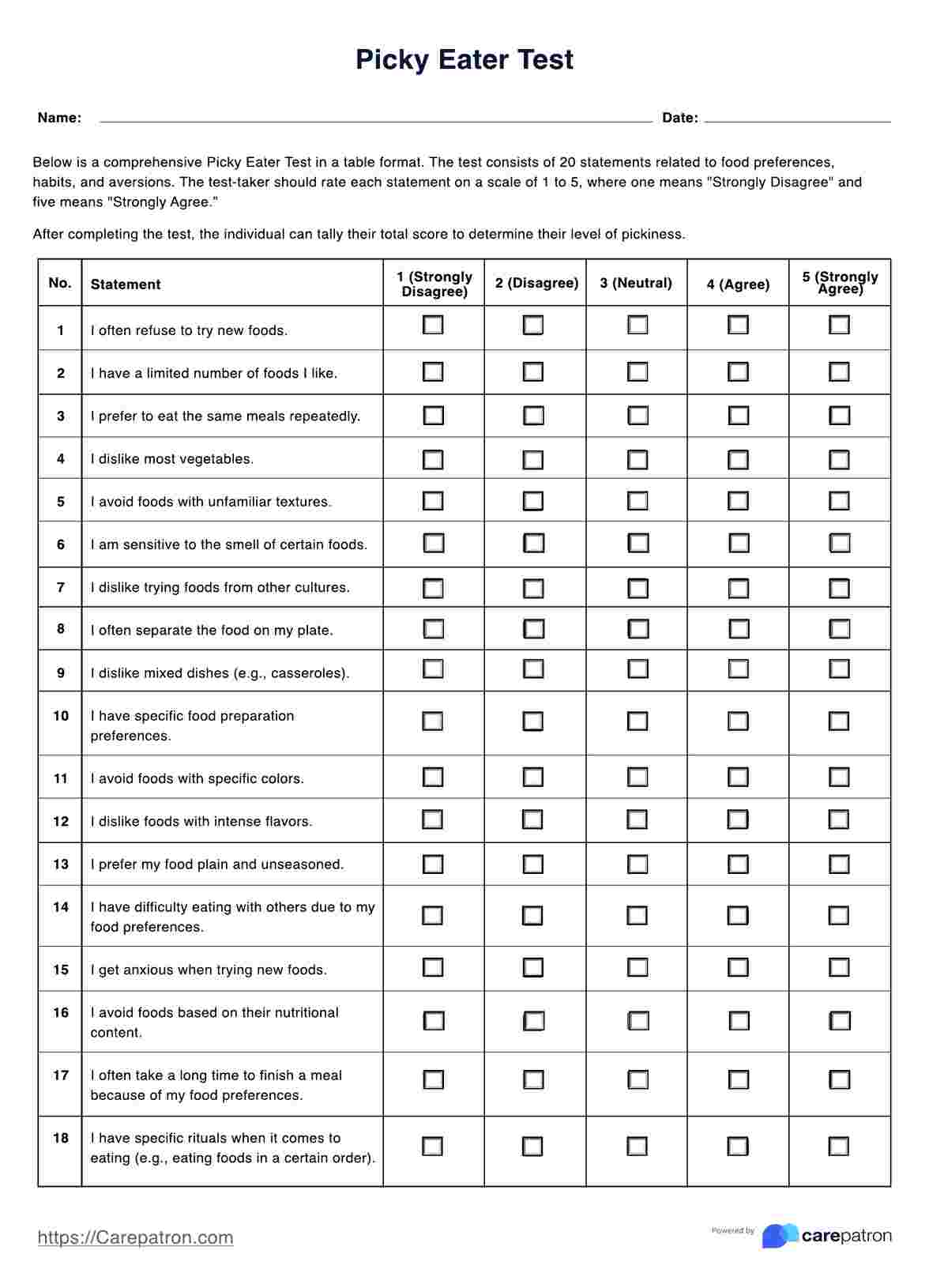
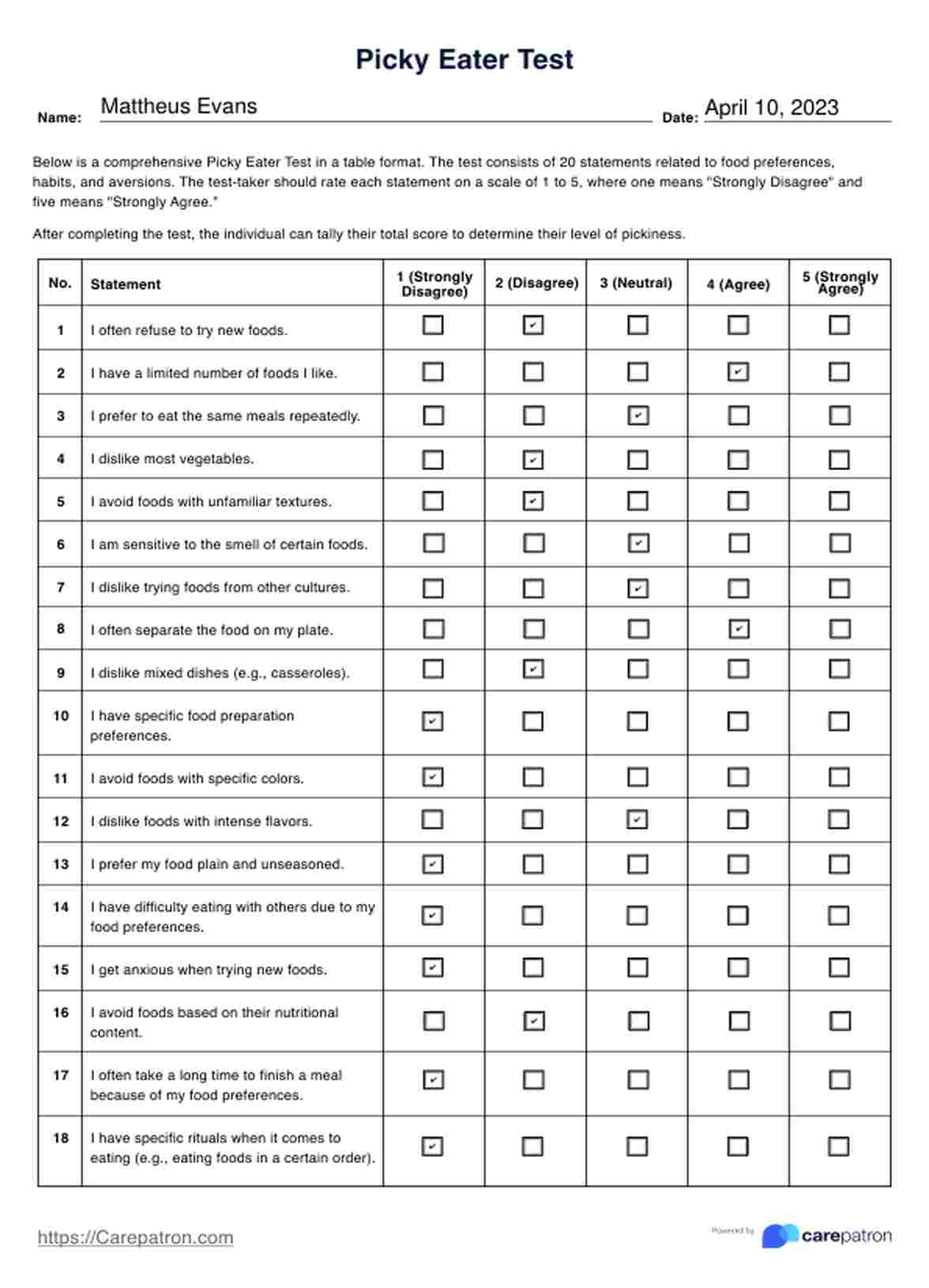


















-template.jpg)

















































































